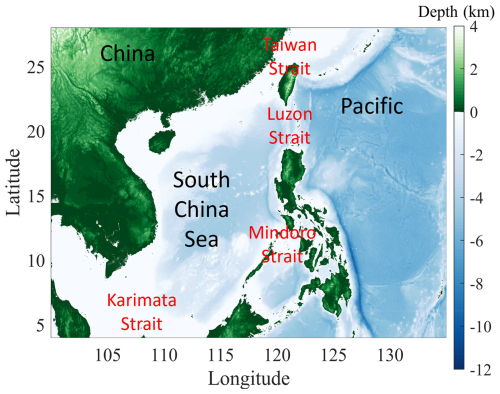the Creative Commons Attribution 4.0 License.
the Creative Commons Attribution 4.0 License.
Topographic modulation on the layered circulation in the South China Sea
Qibang Tang
Zhiqiang Liu
The South China Sea (SCS) is the largest semi-enclosed marginal sea in the western Pacific. It exhibits a unique vertically rotating cyclonic, anticyclonic, and cyclonic circulation in its upper, middle, and deep layers. Over slope topography, these layered currents interact and significantly shape the structure and intensity of the basin circulation. In this study, we employ process-oriented numerical simulations to investigate how upper-layer processes, characterized by greater magnitude and variability, influence the layered circulation over the irregular topographic slope. The simulations reveal that stronger upper intrusion from the open ocean directly enhances upper-layer circulation, which subsequently strengthens the middle and the deep slope currents. Vorticity dynamics illustrate that changes in the middle and deep slope current are largely related to the vertical stretching (ζ_DIV) induced by bottom geostrophic cross-isobath transport (CGTb). As the upper-layer cyclonic slope current intensifies, it modulates the bottom pressure distribution, resulting in stronger negative ζ_DIV predominantly over the northwestern slope to intensify the middle anticyclone slope current. Similarly, for the deep cyclonic slope current, the CGTb maintains downwelling in the northern part and upwelling over the southern slope. Over the southern slope, the strengthening of the positive CGTb is induced by the increment of the advection of relative vorticity and planetary vorticity in the water column, in which the middle layer has an important contribution, but the upper layer has a minimal impact. Conversely, on the northern slope, the strengthening of the negative CGTb is primarily influenced by the upper layer.
- Article
(5919 KB) - Full-text XML
-
Supplement
(521 KB) - BibTeX
- EndNote
Marginal seas circulation plays crucial role in the mass transport and regional climate dynamics, with circulation patterns being strongly influenced by their unique topographic features (Gan et al., 2006; Johns and Sofianos, 2012; Millot, 1999; Oey et al., 2005; Omstedt et al., 2004). This topographic regulation results in intricate layered slope currents that flow in different directions at various depths (Gan et al., 2022; Lan et al., 2013; Wang et al., 2011; Yuan, 2002). These layered currents interact over slope topography, significantly shaping the structure and intensity of the overall circulation (Gan et al., 2016; Quan and Xue, 2018). For instance, in the Gulf of Mexico, loop current eddies influence not just the upper-layer circulation but also the deep flow, illustrating the importance of vertical coupling in transferring energy and variability to deeper currents (Tenreiro et al., 2018). Understanding these dynamics helps elucidate the behavior of the marginal sea's circulation (Liang et al., 2017; Olvera-Prado et al., 2023; Zhu and Liang, 2020).
The South China Sea (SCS) is the largest semi-enclosed marginal sea located in the tropical region. It exhibits a unique mean cyclonic, anticyclonic, and cyclonic (CAC) circulation in its upper, middle, and deep layers (Gan et al., 2016; Lan et al., 2015; Shu et al., 2014; Wang et al., 2011; Zhu et al., 2017). The strong upper-layer circulation is driven by the Asia monsoon and Kuroshio intrusion from Luzon Strait (LS), while the middle and deep circulations are maintained by the outflux and deep intrusion through LS, respectively. Based on current understanding, the upper-layer influx through the Luzon Strait (LS) is induced by the Kuroshio Current as it passes through the strait (Nan et al., 2015). The middle-layer outflux and deep-layer intrusion, on the other hand, are largely driven by density differences caused by contrasting turbulent mixing intensities (e.g., Tian et al., 2009; Zhu et al., 2019; Zhou et al., 2023). Over the slope topography, the CAC circulation affects each other through the vertical coupling among them (Shu et al., 2018). For example, the study of Quan and Xue (2018) demonstrated that perturbations in the upper layer can transit through the water column and affect deeper circulation by altering layer thickness. This coupling is particularly evident over the strong boundary current in the northern basin and along the western boundary. Numerical experiments by Wang et al. (2018) suggest that, although the basin-scale circulation is primarily driven by the LS overflow, upwelling patterns are essential in shaping the detailed structure of the deep-water circulation. Similar processes have been observed in other marginal seas as well (e.g., Testor et al., 2018; Wang et al., 2024; Xu et al., 2009; Olvera-Prado, Moreles et al. 2023).
Previous studies have advanced our understanding of the major features of the mean layered circulation and have highlighted the potential for strong coupling among layers, particularly over sloping topography. However, the response of this circulation to changes in external forcings – particularly the strong upper-ocean processes – and the specific mechanisms involved remain insufficiently understood. A comprehensive understanding of how topographically modulated vertical coupling over basin slopes influences the structure and intensity of mean circulation is crucial for exploring the long-term evolution of marginal sea circulation. For instance, Kuroshio intrusion has been observed to weaken with decadal variations, while upper-ocean currents have shown acceleration in response to a warming climate (Peng et al., 2022; Chen et al., 2020; Nan et al., 2013). How the layered circulation in marginal seas responds to these changes remains unclear. This study employs process-oriented simulations to elucidate how upper-layer processes, which exhibit greater intensity and variability, influence layered circulation over the curved bottom slope in the SCS. The paper is organized as follows: Sect. 2 explains the configuration of the simulation. Section 3 offers the response of layered slope current intensity to the changes in the upper circulation. Section 4 explores the underlying physical mechanisms. Finally, Sect. 5 provides a summary of our findings.
Based on the Regional Ocean Modeling System (ROMS) (Shchepetkin and McWilliams, 2005), we performed a three-dimensional process-oriented simulation in this study (Cai et al., 2023), which employs a simplified setup and allows for a clearer examination of the dynamical coupling between layers. Similar strategies have been applied in previous studies of the SCS circulation (Chen and Xue, 2014; Huang and Zhou, 2022; Quan and Xue, 2018; Wang et al., 2018) and have provided valuable insights into specific dynamic mechanisms.
The model setup included a circular basin in the west representing the SCS and a rectangular basin in the east representing the western Pacific Ocean. The slope in the SCS increases from 400 to 4000 m, and the central basin has a depth of 4000 m. The SCS and Pacific basins were connected by a narrow strait (representing the LS) with a depth of 2500 m. The model employed a uniform horizontal grid with a resolution of 5 km and stretched terrain-following coordinates with 30 vertical layers (Song and Haidvogel, 1994). Near the surface and bottom boundaries, the vertical resolution is refined with a spacing of approximately 0.01, to reduce the spurious flow associated with numerical pressure gradient errors. In this simulation, the magnitude of the spurious flow is on the order of 10−2 m s−1, which has limited impact on the results presented in this study. In the upper layer, an influx of 25 Sv and an outflux of 20 Sv were specified at the southeastern and northeastern boundaries of the open ocean, respectively (Fig. 2c). The SCS was opened to the south with the depth of 400 m (Fig. 2a), to allow the upper-layer intrusion to develop intrinsically during the simulation. To simulate the density differences and exchange currents in the middle and deep layers of the LS, the model incorporated variable contrasting mixing coefficients (Kv) between the SCS and the western Pacific Ocean (Tian et al., 2009; Yang et al., 2016). In the SCS and the western half of the LS, Kv values were set as m2 s−1 between 500 and 1500 m, 2× 10−3 m2 s−1 below 1500 m, and 5× 10−3 m2 s−1 in the layer 500 m from the bottom. In the upper 500 m of the SCS and LS, and throughout the entire water column of the open ocean, a background Kv of m2 s−1 was applied. The Kv was designed based on observational work by Yang et al. (2016) and estimations by Wang et al. (2017) to form the circulation in the semi-enclosed middle and deep layers. Then, simulations were conducted to explore the response of the layered slope current, particularly in the semi-enclosed middle and deep layers, to changes in the upper-layer circulation. While it may be viewed as parameter tuning, our intention was not to simulate the mixing generation mechanisms explicitly but rather to approximate the existing background structure that sustains the observed layered circulation. A zonal wind stress with meridional variations was applied over the open ocean, while the atmospheric buoyancy flux over the SCS was simplified by setting it to zero. This model simplifies the configurations to focus on the fundamental dynamics of the system. While these simplifications are essential for isolating key mechanisms, they may not capture the complexity of real-world conditions, potentially limiting its quantitative applicability to realistic processes.
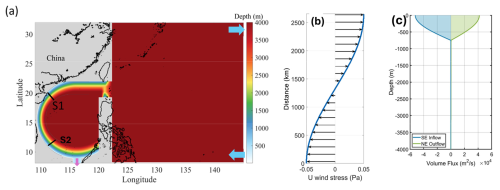
Figure 2(a) The topography and geometry used in the idealized process-oriented simulation. The black lines show the realistic surrounding coastline. S1 and S2 are two vertical sections for showing slope current. (b) Distribution of the wind stress. (c) Vertical profile of the volume inflow/outflux (m2 s−1) through the southern/northern part of the eastern boundary.
The model was initialized with horizontally uniform temperature and salinity profiles derived from the mean data of the World Ocean Atlas, averaged over the region west of the LS. The simulation ran for 25 years, with the analysis conducted on the results from the final 5-year average after the layered circulation reached a stable state.
In the LS, the influx occurs in the upper and deep layers, while the outflux occurs in the middle layer between them (Fig. 3b). The upper intrusion is intrinsically linked to the western boundary current in the open ocean, i.e., the Kuroshio Current. In the middle and bottom layers, the exchange currents are primarily related to the density differences between the South China Sea (SCS) and the Pacific. Although the initial temperature and salinity distributions are horizontally uniform, the intensified turbulent mixing within the deep SCS basin gradually leads to a density difference between the two sides of the LS. Specifically, the deep SCS exhibits lower density compared to the Pacific Basin (Fig. S1). Under the density difference, the westward pressure gradient was formed that drives the deep intrusion from the open ocean towards the SCS. Those features are consistent with established understandings from previous studies (Wang et al., 2011). Associated with the simulated layered exchanging current, the layered circulations developed inside the SCS basin. The upper, middle, and deep layers exhibit circulation in cyclonic, anticyclonic, and cyclonic directions, respectively (Fig. S1). The horizontally averaged vorticity is featured with the positive–negative–positive values in the respective depth of the basin (Fig. 3b).
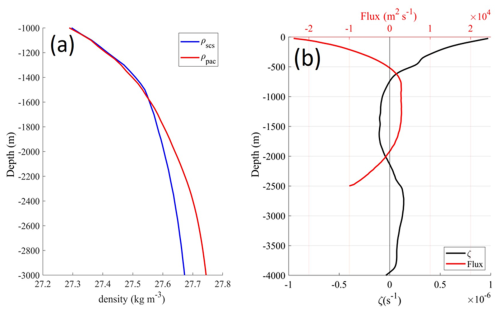
Figure 3(a) Vertical profile of domain-averaged density ρ (kg m−3) in the SCS and Pacific between 1000 and 3000 m. (b) The black line shows the vertical profile of the SCS basin-averaged vorticity (s−1), and the red line shows the flux through LS (m2 s−1). The positive/negative vorticity represents the cyclonic/anticyclonic circulation, and the positive/negative value flux represents the outflux/influx through LS.
To investigate how the changes in upper-layer current modulate the layered circulation, additional numerical experiments were conducted by adjusting the northeastern outflux to 22, 23, and 24 Sv. Thus, the upper LS intrusion was adjusted to 3 Sv (Case_U3), 2 Sv (Case_U2), and 1 Sv (Case_U1). In these scenarios, the middle and deep exchanging currents, which were primarily sustained by the contrasting densities between the SCS and the open ocean, remained relatively unchanged (Fig. 4a). Inside the basin, the enhancement of the upper-layer inflow directly intensified the upper-layer cyclonic circulation (Fig. 4c–f). And subsequently it strengthened the middle anticyclonic slope current, particularly in the northwestern part of the basin (transect S1, Fig. 4c, d). Additionally, although not directly connected to the upper layer, the deep cyclonic slope current also exhibited increased strength (Fig. 4c–f). Using the domain-averaged vorticity as an indicator, it was observed that the intensification of the upper-layer circulation resulted in a 10 % increase in the intensity of the middle anticyclonic circulation and a 27 % increase in the deep cyclonic circulation (Fig. 4b). Given that only the upper-layer circulation is directly amplified by the upper intrusion, the remote influence from upper-layer processes over the basin slope significantly impacts the intensity of the layered circulation, which was explored below.
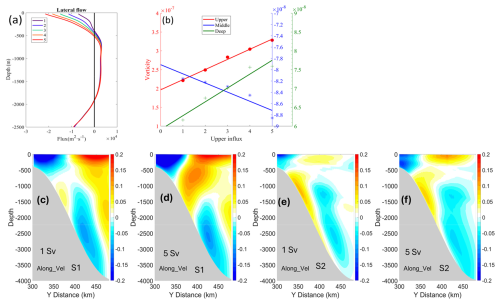
Figure 4(a) Vertical profile flux across the LS under varying upper-layer influx. (b) Changes in the basin-averaged vorticity between 0–500 m (upper), 1000–2000 m (middle), and 3000–4000 m (deep) with different upper influxes. (c–f) The along-slope current (m s−1) over the sections S1 and S1 in the standard case (upper intrusion is 5 Sv) and Case_U1 (upper LS intrusion is 1 Sv), respectively. The locations of the two transects are shown in Fig. 1a. The transect locations are indicated in Fig. 1a. Positive values represent anticyclonic flow, while negative values indicate cyclonic flow.
To understand how the upper-layer processes modulate the layered current over the slope, we first investigated the layered-integrated vorticity budget for each layer (Cai et al., 2023; Gan et al., 2016):
where PGF is pressure gradient force, ADV is nonlinear advection, and HVIS and VVIS are the horizontal and vertical turbulent viscosity, respectively. COR is the Coriolis force, and the domain-integrated ζ_COR represents the lateral planetary vorticity flux. The H1 and H2 represent the bottom and upper depth of each layer, respectively. Inside the basin, the ζ_COR can be further decomposed into the vertical stretching induced by the divergence of the horizontal flow (ζ_DIV) and β effect of the meridional current (ζ_BETA).
The circulation in the SCS is primarily governed by geostrophic balance, manifested as ζ_COR balanced by the ζ_PGF in both layers. It suggests that the mean cyclonic/anticyclonic circulation is related to the lateral planetary vorticity influx/outflux (Fig. 5) (Cai et al., 2023; Cai and Gan, 2019). Consequently, the strengthening of the upper LS intrusion directly intensifies the upper-layer cyclonic slope current by providing more positive planetary vorticity flux. In the semi-enclosed middle and deep layers, the vorticity input is mainly provided by the ζ_DIV, as also highlighted in previous studies (Cai et al., 2023; Wang et al., 2018; Zhu et al., 2017). The positive ζ_DIV in the upper and deep layers reflects the downward and upward fluxes, which squeeze the middle layer and provide the negative vertical flux (negative ζ_DIV) for the anticyclonic circulation. Therefore, the intensification of the middle and deep slope currents is largely attributed to vertical stretching over the basin slope.

Figure 5The layered-integrated vorticity budget (Eq. 1) for the standard case in the layers of (a) 0–500, (b) 1000–2000, and (c) 2500–4000 m.
4.1 Intensification of middle anticyclonic slope current
For the middle anticyclonic slope current, the negative middle-layered ζ_DIV (ζ_DIVM) mainly occurs over the northwestern slope (Fig. 6a), where a relatively strong anticyclonic slope current is observed. In this area, the upper layer generally exhibits positive ζ_DIV (ζ_DIVU), indicating downward squeezing from the upper layer that helps maintain the middle anticyclonic slope current (Fig. 6b). The increased squeezing from the upper-slope current is expected to intensify the middle anticyclonic slope current (Fig. 4c, d). Since the stretching/squeezing imposed on the slope current is closely related to the vertical motion (Liang et al., 2017), the mean vertical motions over the slope can be understood as follows:
where H is the topography, and _geo represents the geostrophic component of the horizontal current, which is maintained by the distribution of bottom pressure. _vis represents the vertical viscosity component. Hx and Hy are the horizontal gradients of the bottom slope, and and are the bottom geostrophic currents. When the current flows over the slope, the bottom pressure distribution interacts with the curved topography and the resulting geostrophic cross-isobath transport (CGTb) to influence the vertical motions over the slope. The “Fric” represents the effect of the bottom Ekman pumping induced by the bottom stress of the slope current. Generally, the CGTb largely governs the mean vertical motion over northwestern slope, which in turn squeezes and stretches the middle- and upper-slope currents. This process is crucial in maintaining the vorticity input through ζ_DIV (Fig. 6d), thereby sustaining the dynamics of the slope currents.
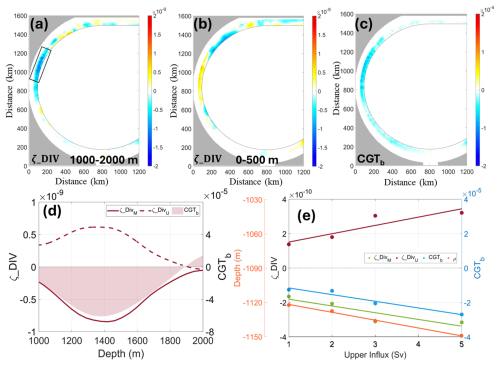
Figure 6(a–c) ζ_DIV integrated between 1000–2000 m (ζ_DIVM ), 0–500 m (ζ_DIVU), and CGTb over the region of middle anticyclonic slope current between 1000–2000 m. The black line indicates the 2000 m isobath line. (d) Change in the ζ_DIV integrated between 100–2000 m (ζ_DIVM) and between 0–500 m (ζ_DIVU) with the depth over the northwestern slope. (e) Changes in the ζ_DIVM, ζ_DIVU, CGTb ,and the depth of isopycnal surface of 1027.4 kg m−3 with different upper LS influxes. Panels (d) and (e) are plotted using the data averaged over the region of the black box in (a).
Associated with the intensification of the upper-layer cyclonic slope current, the stronger slope current modulates the bottom pressure distribution over the slope, leading to stronger vertical squeezing (ζ_DIV) within the water column. The increase in squeezing gradually deepens the isopycnal surface and strengthens the middle anticyclonic slope current (Fig. 6e).
4.2 Intensification of the deep cyclonic slope current
For the deep cyclonic slope current, the deep ζ_DIV (ζ_DIVD) features a downward flux (negative value) over the northern slope and upward flux (positive value) over the southern part (Fig. 7a, d). It suggests the sinking from the northern basin and upwelling from the southern basin would sustain the abyssal cyclonic circulation. The ζ_DIVD is the same as the middle anticyclonic slope current. For the deep layer, the viscosity term has an important effect in the vorticity budget (Fig. 5c). Similarly, the FricD term contributes to the deep ζ_DIVD and is characterized by a relatively uniform downward motion (Fig. 7d). However, the primary pattern and magnitude of the ζ_DIVD are largely controlled by the CGTb that the pressure distribution maintained the mean downwelling in the northern side and the upwelling over the southern slope (Fig. 7b, d). Since the FricD is induced by the bottom frictional stress as a response to the deep layer slope current, while the bottom pressure is modulated by the motions of water in the entire water column above it, we further examine the maintenance of the bottom pressure over the slope.
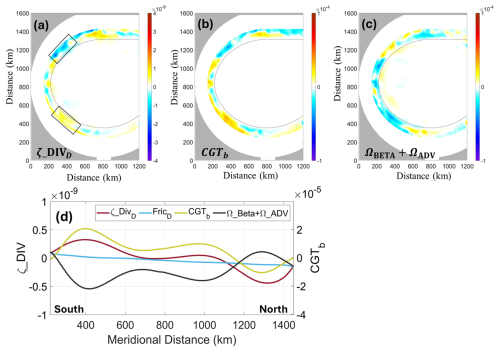
Figure 7(a–c) ζ_DIV integrated below 3000 m of the deep cyclonic slope current (ζ_DIVD), CGTb, and Ω_BETA + Ω_ADV over the region of the middle anticyclonic slope current below 3000 m. The black line indicates the 4000 m isobath line. (d) Meridional changes in the ζ_DIVD, FricD, CGTb, and Ω_BETA+ Ω_ADV over the slope.
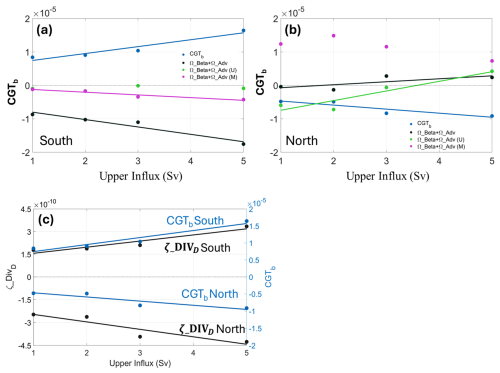
Figure 8(a) Changes in the CGTb, ΩBeta+ ΩAdv in the total water column, ΩBeta+ΩAdv in the layer between 0–500 m (ΩBeta_U+ΩAdv_U), and ΩBeta+ΩAdv between 1000–2000 m (ΩBeta_M+ΩAdv_M) over the southern slope (black box in Fig. 8a). (b) The same as (a) but over the northern slope (black box in Fig. 8a). (c) Change in the CGTb and ζ_DIVD over the northern and southern slope.
To explain the maintenance of the bottom pressure distribution, the vertical integrated vorticity dynamic was employed (Cai and Gan, 2021; Gan et al., 2013):
where ) and thus represents the effect of CGTb. It illustrates that the bottom pressure distribution is maintained by the nonlinear advection of relative vorticity (Ω_ADV), advection of planetary vorticity (Ω_BETA), and net viscosity of the current flowing over the slope topography. Among them, the Ω_BETA and Ω_ADV play the major role in sustaining the bottom pressure distribution of the deep cyclonic slope current (Fig. 8c, d).
As the upper intrusion intensifies, the bottom pressure distribution adjusts in response to changes in the layered circulation, resulting in a gradual strengthening of the negative CGTb over the northern slope and positive CGTb over the southern part (Fig. 8a–b). Over the southern slope (Fig. 8a), the strengthening of the positive CGTb is induced by the increase of the Ω_BETA+Ω_ADV in the water column, in which the middle layer [Ω_BETA+Ω_ADV (M)] provides approximately 40 % of the total strengthening trend, while the upper layer [Ω_BETA+Ω_ADV (U)] has a negligible impact. Conversely, over the northern slope, the strengthening of the Ω_BETA+ Ω_ADV is primarily influenced by the upper layer, while the middle layer has a negative effect (Fig. 8b). Thus, the intensification of downward CGTb over the northern slope is directly modulated by the strengthening of the upper-cyclonic-slope current, while the intensification of upward CGTb over the southern slope is mainly driven by the strengthening of the middle anticyclonic slope current. These changes in CGTb enhance deep stretching, thereby strengthening the deep cyclonic slope current accordingly (Fig. 8c).
Marginal sea circulation plays a crucial role in mass transport and regional climate dynamics. Through process-oriented numerical simulations, we examined how upper-layer processes, which are characterized by greater intensity and variability, impact the layered circulation over the curved bottom slope in the SCS. The primary goal of our study is to provide theoretical insights into the mechanisms driving layered circulation and their response to changes in upper-layer motions. The results underscore the intricate balance between topographical features and oceanic circulation. These insights have broad applicability to understanding similar processes and phenomena in other regions and help to predict the behavior of marginal sea circulation under varying forcing conditions.
The numerical experiments show that the simulated layered exchange currents through the LS introduce lateral planetary vorticity flux and facilitate the development of a layered basin circulation within the SCS. Inside the basin, the intensification of upper-layer inflow directly enhances the upper-layer cyclonic circulation, which in turn strengthens the middle anticyclonic slope current, particularly in the northwestern part of the basin. Furthermore, even though the deep cyclonic slope current is not directly connected to the upper layer, it also exhibits increased strength. Using domain-averaged vorticity as an indicator, it was found that the intensification of the upper-layer circulation resulted in the increase in the intensity of the middle anticyclonic circulation and deep cyclonic circulation.
The vorticity dynamics illustrate that the changes in the middle and deep slope current are largely related to the vertical stretching over the slope (ζ_DIV). When the current flows over the slope, the bottom pressure distribution interacts with the curved topography, and the resulting geostrophic cross-isobath transport (CGTb) influences the vertical motions. For the middle anticyclonic slope current, the negative middle ζ_DIV predominantly occurs over the northwestern slope, where a relatively strong anticyclonic slope current is present. As the upper-layer cyclonic slope current intensifies, it modulates the bottom pressure distribution over the slope, providing stronger vertical squeezing ζ_DIV within the water column, which gradually strengthens the middle anticyclonic slope current. For the deep cyclonic slope current, the deep ζ_DIV is also largely controlled by the CGTb over the slope, with the pressure distribution maintaining downwelling flows in the northern part and upwelling over the southern slope. Over the southern slope, the strengthening of the positive CGTb is induced by the increase of the nonlinear advection of relative vorticity and planetary vorticity in the entire water column, in which the middle layer provides approximately 40 % of the total strengthening trend, while the upper layer has a negligible impact. Conversely, on the northern slope, the strengthening of the negative CGTb is primarily influenced by the upper layer, while the middle layer has a negative effect.
The results from this process-oriented study offered clear processes for understanding vertical coupling among circulation layers. The motions in one layer influence others by modifying the along-slope pressure distribution and corresponding stretching, thereby facilitating inter-layer interaction. It should be noted that those understandings are based on process-oriented simulations with simplified configurations. Based on the obtained understanding, a more realistic simulation in our following study, incorporating detailed topography and external forcings, will offer more quantitative insights and help further validate and extend the findings presented here. In addition to the processes revealed in this study, other mechanisms, such as the Neptune effect involving the eddy–slope interaction (e.g., Holloway, 1987; Stewart et al., 2024), may also play a role in influencing circulation dynamics in marginal seas like the SCS. It will be incorporated into our future investigations to improve understanding.
All data and source code used in this paper are available at https://doi.org/10.5281/zenodo.15081223 (Cai, 2025).
The supplement related to this article is available online at https://doi.org/10.5194/os-21-1291-2025-supplement.
QT conducted the investigation, developed the methodology, and carried out the writing (original draft preparation). ZC was responsible for the conceptualization, supervision, and writing (review and editing). ZL was responsible for the conceptualization and writing (review and editing).
The contact author has declared that none of the authors has any competing interests.
Publisher’s note: Copernicus Publications remains neutral with regard to jurisdictional claims made in the text, published maps, institutional affiliations, or any other geographical representation in this paper. While Copernicus Publications makes every effort to include appropriate place names, the final responsibility lies with the authors.
This work was supported by National Natural Science Foundation of China (grant nos. 42376024, 42276004), the Science and Technology Development Fund, Macau SAR (file/project no. 001/2024/SKL, 0040/2023/R1A1). The work described in this paper was substantially supported by a grant from the Research Grants Council of the Hong Kong Special Administrative Region, China (AoE/P-601/23-N). CORE is a joint research center for ocean research between Laoshan Laboratory and HKUST. This work was performed in part at the SICC, which is supported by the SKL-IOTSC, University of Macau.
This research has been supported by the National Natural Science Foundation of China (grant nos. 42376024 and 42276004), the Fundo para o Desenvolvimento das Ciências e da Tecnologia (grant no. 001/2024/SKL, 0040/2023/R1A1), and the Research Grants Council, University Grants Committee (grant no. AoE/P-601/23-N).
This paper was edited by Anne Marie Treguier and reviewed by three anonymous referees.
Cai, Z.: Topographic modulation on the layered circulation in South China Sea, Zenodo [data set], https://doi.org/10.5281/zenodo.15081223, 2025.
Cai, Z. and Gan, J.: Coupled External-Internal Dynamics of Layered Circulation in the South China Sea: A Modeling Study, J. Geophys. Res.-Oceans, 124, 5039–5053, https://doi.org/10.1029/2019JC014962, 2019.
Cai, Z. and Gan, J.: Dynamics of the Layered Circulation Inferred from Kinetic Energy Pathway in the South China Sea, J. Phys. Oceanogr., 51, 1671–1685, https://doi.org/10.1175/jpo-d-20-0226.1, 2021.
Cai, Z., Chen, D., and Gan, J.: Formation of the layered circulation in South China Sea with the mixing stimulated exchanging current through Luzon Strait, J. Geophys. Res.-Oceans, e2023JC019730, https://doi.org/10.1029/2023JC019730, 2023.
Chen, G. and Xue, H.: Westward intensification in marginal seas, Ocean Dynam., 64, 337–345, https://doi.org/10.1007/s10236-014-0691-z, 2014.
Chen, Y., Zhai, F., and Li, P.: Decadal variation of the Kuroshio intrusion into the South China Sea during 1992–2016, J. Geophys. Res.-Oceans, 125, e2019JC015699, https://doi.org/10.1029/2019JC015699, 2020.
Gan, J., Li, H., Curchitser, E. N., and Haidvogel, D. B.: Modeling South China Sea circulation: Response to seasonal forcing regimes, J. Geophys. Res., 111, 1–20, https://doi.org/10.1029/2005jc003298, 2006.
Gan, J., Liang, L., and San Ho, H.: Dynamics of Intensified Downwelling Circulation over a Widened Shelf in the Northeastern South China Sea, J. Phys. Oceanogr., 43, 80–94, https://doi.org/10.1175/jpo-d-12-02.1, 2013.
Gan, J., Liu, Z., and Hui, C. R.: A Three-Layer Alternating Spinning Circulation in the South China Sea, J. Phys. Oceanogr., 46, 2309–2315, https://doi.org/10.1175/jpo-d-16-0044.1, 2016.
Gan, J., Kung, H., Cai, Z., Liu, Z., Hui, C., and Li, J.: Hotspots of the stokes rotating circulation in a large marginal sea, Nat. Commun., 13, 2223, https://doi.org/10.1038/s41467-022-29610-z, 2022.
Holloway, G.: Systematic forcing of large-scale geophysical flows by eddy-topography interaction, J. Fluid Mech., 184, 463–476, https://doi.org/10.1017/S0022112087002970, 1987.
Huang, R. X. and Zhou, H.: Circulation in the South China Sea is in a state of forced oscillation: Results from a simple reduced gravity model with a closed boundary, Acta Oceanol. Sin., 41, 1–12, https://doi.org/10.1007/s13131-022-2013-5, 2022.
Johns, W. E. and Sofianos, S. S.: Atmospherically Forced Exchange through the Bab el Mandeb Strait, J. Phys. Oceanogr., 42, 1143–1157, https://doi.org/10.1175/jpo-d-11-0157.1, 2012.
Lan, J., Zhang, N., and Wang, Y.: On the dynamics of the South China Sea deep circulation, J. Geophys. Res.-Oceans, 118, 1206–1210, https://doi.org/10.1002/jgrc.20104, 2013.
Lan, J., Wang, Y., Cui, F., and Zhang, N.: Seasonal variation in the South China Sea deep circulation, J. Geophys. Res.-Oceans, 120, 1682–1690, https://doi.org/10.1002/2014jc010413, 2015.
Liang, X., Spall, M., and Wunsch, C.: Global Ocean Vertical Velocity From a Dynamically Consistent Ocean State Estimate, J. Geophys. Res.-Oceans, 122, 8208–8224, https://doi.org/10.1002/2017JC012985, 2017.
Millot, C.: Circulation in the Western Mediterranean Sea, J. Marine Syst., 20, 423–442, https://doi.org/10.1016/S0924-7963(98)00078-5, 1999.
Nan, F., Xue, H., Chai, F., Wang, D., Yu, F., Shi, M., Guo, P., and Xiu, P.: Weakening of the Kuroshio Intrusion into the South China Sea over the Past Two Decades, J. Climate, 26, 8097–8110, https://doi.org/10.1175/JCLI-D-12-00315.1, 2013.
Nan, F., Xue, H., and Yu, F.: Kuroshio intrusion into the South China Sea: A review, Prog. Oceanogr., 137, 314–333, https://doi.org/10.1016/j.pocean.2014.05.012, 2015.
Oey, L. Y., Ezer, T., and Lee, H. C.: Loop Current, Rings and Related Circulation in the Gulf of Mexico: A Review of Numerical Models and Future Challenges, in Circulation in the Gulf of Mexico: Observations and Models, edited by: Sturges, W. and Lugo-Fernandez, A., Wiley, 31–56, https://doi.org/10.1029/161GM04, 2005.
Olvera-Prado, E. R., Moreles, E., Zavala-Hidalgo, J., and Romero-Centeno, R.: Upper–Lower Layer Coupling of Recurrent Circulation Patterns in the Gulf of Mexico, J. Phys. Oceanogr., 53, 533–550, https://doi.org/10.1175/JPO-D-21-0281.1, 2023.
Omstedt, A., Elken, J., Lehmann, A., and Piechura, J.: Knowledge of the Baltic Sea physics gained during the BALTEX and related programmes, Prog. Oceanogr., 63, 1–28, https://doi.org/10.1016/j.pocean.2004.09.001, 2004.
Peng, Q., Xie, S. P., Wang, D., Huang, R. X., Chen, G., Shu, Y., Shi, J. R., and Liu, W.: Surface warming-induced global acceleration of upper ocean currents, Sci. Adv., 8, eabj8394, 1–12, https://doi.org/10.1126/sciadv.abj8394, 2022.
Quan, Q. and Xue, H.: Layered model and insights into the vertical coupling of the South China Sea circulation in the upper and middle layers, Ocean Model., 129, 75–92, https://doi.org/10.1016/j.ocemod.2018.06.006, 2018.
Shchepetkin, A. F. and McWilliams, J. C.: The regional oceanic modeling system (ROMS): a split-explicit, free-surface, topography-following-coordinate oceanic model, Ocean Model., 9, 347–404, https://doi.org/10.1016/j.ocemod.2004.08.002, 2005.
Shu, Y., Xue, H., Wang, D., Chai, F., Xie, Q., Yao, J., and Xiao, J.: Meridional overturning circulation in the South China Sea envisioned from the high-resolution global reanalysis data GLBa0.08, J. Geophys. Res.-Oceans, 119, 3012–3028, https://doi.org/10.1002/2013jc009583, 2014.
Shu, Y., Wang, Q., and Zu, T.: Progress on shelf and slope circulation in the northern South China Sea, Science China Earth Sciences, 61, 560–571, https://doi.org/10.1007/s11430-017-9152-y, 2018.
Song, Y. and Haidvogel, D.: A semi-implicit ocean circulation model using a generalized topography-following coordinate system, J. Comput. Phys., 115, 228–244, https://doi.org/10.1006/jcph.1994.1189, 1994.
Stewart, A. L., Wang, Y., Solodoch, A., Chen, R., and McWilliams, J. C.: Formation of Eastern Boundary Undercurrents via Mesoscale Eddy Rectification, J. Phys. Oceanogr., 54, 1765–1785, https://doi.org/10.1175/JPO-D-23-0196.1, 2024.
Tenreiro, M., Candela, J., Sanz, E. P., Sheinbaum, J., and Ochoa, J.: Near-Surface and Deep Circulation Coupling in the Western Gulf of Mexico, J. Phys. Oceanogr., 48, 145–161, https://doi.org/10.1175/jpo-d-17-0018.1, 2018.
Testor, P., Bosse, A., Houpert, L., Margirier, F., Mortier, L., Legoff, H., Dausse, D., Labaste, M., Karstensen, J., Hayes, D., Olita, A., Ribotti, A., Schroeder, K., Chiggiato, J., Onken, R., Heslop, E., Mourre, B., D'ortenzio, F., Mayot, N., Lavigne, H., de Fommervault, O., Coppola, L., Prieur, L., Taillandier, V., Durrieu de Madron, X., Bourrin, F., Many, G., Damien, P., Estournel, C., Marsaleix, P., Taupier-Letage, I., Raimbault, P., Waldman, R., Bouin, M.-N., Giordani, G., Caniaux, G., Somot, S., Ducrocq, V., and Conan, P.: Multiscale Observations of Deep Convection in the Northwestern Mediterranean Sea During Winter 2012–2013 Using Multiple Platforms, J. Geophys. Res.-Oceans, 123, 1745–1776, https://doi.org/10.1002/2016JC012671, 2018.
Tian, J., Yang, Q., and Zhao, W.: Enhanced diapycnal mixing in the South China Sea, J. Phys. Oceanogr., 39, 3191–3203, https://doi.org/10.1175/2009JPO3899.1, 2009.
Wang, A., Du, Y., Peng, S., Liu, K., and Huang, R. X.: Deep water characteristics and circulation in the South China Sea, Deep-Sea Res. Pt. I, 134, 55–63, https://doi.org/10.1016/j.dsr.2018.02.003, 2018.
Wang, G., Xie, S.-P., Qu, T., and Huang, R. X.: Deep South China Sea circulation, Geophys. Res. Lett., 38, 1–6, https://doi.org/10.1029/2010gl046626, 2011.
Wang, Q., Chen, J., He, Y., Wang, D., and Xiu, P.: Warming of the lower ocean layer modulated by vertical advection prior to typhoon arrival, Clim. Dynam., 62, 4411–4428, https://doi.org/10.1007/s00382-024-07157-7, 2024.
Wang, X., Liu, Z., and Peng, S.: Impact of Tidal Mixing on Water Mass Transformation and Circulation in the South China Sea, J. Phys. Oceanogr., 47, 419–432, https://doi.org/10.1175/jpo-d-16-0171.1, 2017.
Xu, Y., Watts, D. R., and Wimbush, M.: Coupled patterns between fields of dynamic height and bottom pressure in the Japan/East Sea, Ocean Sci. J., 44, 35–42, https://doi.org/10.1007/s12601-009-0005-4, 2009.
Yang, Q., Zhao, W., Liang, X., and Tian, J.: Three-Dimensional Distribution of Turbulent Mixing in the South China Sea, J. Phys. Oceanogr., 46, 769–788, https://doi.org/10.1175/jpo-d-14-0220.1, 2016.
Yuan, D.: A numerical study of the South China Sea deep circulation and its relation to the Luzon Strait transport, Acta Oceanol. Sin., 2, 187–202, 2002.
Zhou, C., Xiao, X., Zhao, W., Yang, J., Huang, X., Guan, S., Zhang, Z., and Tian, J.: Increasing deep-water overflow from the Pacific into the South China Sea revealed by mooring observations, Nat. Commun., 14, 1–9, https://doi.org/10.1038/s41467-023-37767-4, 2023.
Zhu, Y. and Liang, X.: Coupling of the Surface and Near-Bottom Currents in the Gulf of Mexico, J. Geophys. Res.-Oceans, 125, e2020JC016488, https://doi.org/10.1029/2020JC016488, 2020.
Zhu, Y., Sun, J., Wang, Y., Wei, Z., Yang, D., and Qu, T.: Effect of potential vorticity flux on the circulation in the South China Sea, J. Geophys. Res.-Oceans, 122, 6454–6469, https://doi.org/10.1002/2016JC012375, 2017.
Zhu, Y., Sun, J., Wang, Y., Li, S., Xu, T., Wei, Z., and Qu, T.: Overview of the multi-layer circulation in the South China Sea, Prog. Oceanogr., 175, 171–182, https://doi.org/10.1016/j.pocean.2019.04.001, 2019.





